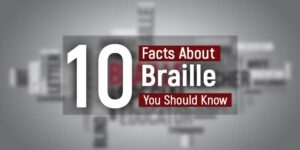Music has always been a source of joy and inspiration for people around the world, but for individuals with visual impairments, enjoying and learning music can be a significant challenge. In recent years, Braille Music Transcription has emerged as a crucial tool for making music accessible to visually impaired students. In this blog post, we will explore the role of Braille Music Transcription in education and how it can help students with visual impairments.
What is Braille Music Transcription?
Music Braille Transcription is a process of converting musical scores into Braille notation. It involves using a combination of Braille symbols and musical notation to represent the melody, harmony, rhythm, and other elements of a musical composition. This process enables visually impaired individuals to read and interpret musical scores, and thus participate in music education and performances.
The Role of Braille Music Transcription in Education
For visually impaired students, learning music can be a challenging task, as they cannot rely on visual cues to read musical scores. This is where Music Braille Transcription comes into play. By transcribing musical scores into Braille notation, teachers and educators can provide visually impaired students with the tools they need to learn and appreciate music.
One of the most significant benefits of Braille Music Transcription is that it allows visually impaired students to read and play music independently. By using Braille music scores, students can learn at their own pace and practice as much as they want, without the need for constant assistance from teachers or peers. This empowers visually impaired students to take control of their learning and build their confidence in music.
Another essential role of Braille Music Transcription in education is that it helps visually impaired students to develop their cognitive and sensory skills. When playing an instrument or singing, students must focus their attention on the notes, tempo, and rhythm, which requires a high level of concentration. By regularly practicing music, visually impaired students can develop the ability to concentrate for longer periods, which can be helpful in other areas of their education.
Braille Music can also help visually impaired students to enhance their coordination skills. Playing an instrument or singing requires hand-eye coordination, finger dexterity, and physical movement, which can be challenging for visually impaired students. By practicing music regularly, they can improve their coordination skills and develop greater control over their body movements.
In addition to improving cognitive and sensory skills, Music Braille Transcription can also stimulate visually impaired students’ senses and help them to explore and appreciate the world of sound. Music is a form of art that can create an emotional connection with listeners, and visually impaired students are no exception. By experiencing music, they can connect with different emotions and feelings, which can be a powerful tool in their personal and educational development.
The Impact of Braille Music Transcription on Visually Impaired Students
The impact of Braille Music Transcription on visually impaired students is significant. By providing visually impaired students with access to musical scores and instruments, educators can open up a world of opportunities for them. Students can develop their skills in singing, playing instruments, composing music, and even pursuing a career in music.
Moreover, music education can have a positive impact on the overall development of visually impaired students. It can boost their self-esteem, improve their social skills, and provide them with a sense of belonging and purpose. By enabling visually impaired students to participate in music, educators can help them to lead fulfilling and meaningful lives.
Conclusion
Music Braille Transcription is a powerful tool for making music accessible to visually impaired students. It enables them to read and interpret musical scores independently, develop their cognitive and sensory skills, and pursue their passion for music.
At Braille Music and More, we can manage braille transcription projects for schools in various subject matters including Literary (English, History, etc.), Music, Maths, Sciences, Foreign Languages, Tactile Graphics, and more.
With over 25 of the most skilled Braille Transcribers in America, and the expert leadership of our founder Patrick Janson, we have delivered braille transcriptions that are precise and on time. Whether it’s basic kindergarten materials or complicated doctorate-level Pharmaceutical Studies textbooks and materials, Braille Music and More has the expertise and professionalism to handle it all.






